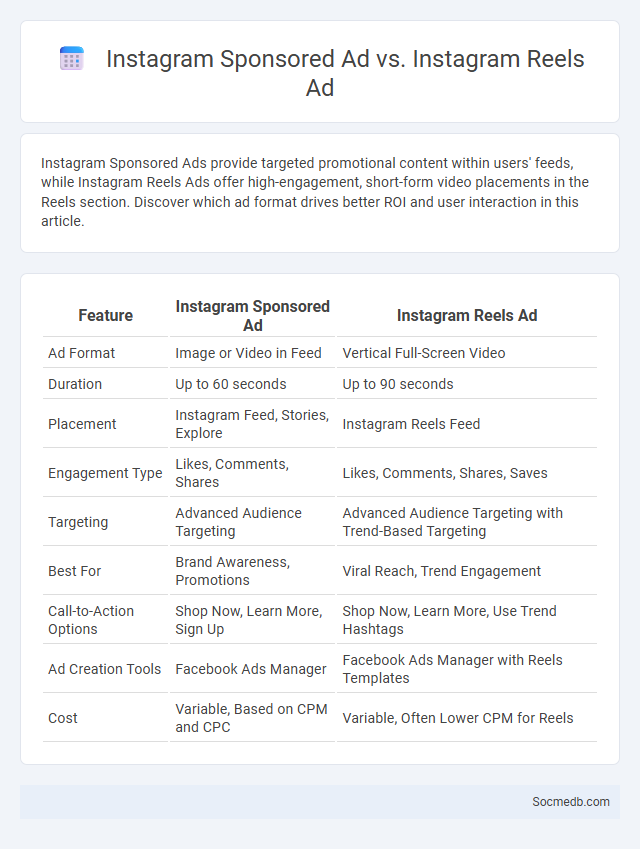
Photo illustration: Instagram Sponsored Ad vs Instagram Reels Ad
Instagram Sponsored Ads provide targeted promotional content within users' feeds, while Instagram Reels Ads offer high-engagement, short-form video placements in the Reels section. Discover which ad format drives better ROI and user interaction in this article.
Table of Comparison
| Feature | Instagram Sponsored Ad | Instagram Reels Ad |
|---|---|---|
| Ad Format | Image or Video in Feed | Vertical Full-Screen Video |
| Duration | Up to 60 seconds | Up to 90 seconds |
| Placement | Instagram Feed, Stories, Explore | Instagram Reels Feed |
| Engagement Type | Likes, Comments, Shares | Likes, Comments, Shares, Saves |
| Targeting | Advanced Audience Targeting | Advanced Audience Targeting with Trend-Based Targeting |
| Best For | Brand Awareness, Promotions | Viral Reach, Trend Engagement |
| Call-to-Action Options | Shop Now, Learn More, Sign Up | Shop Now, Learn More, Use Trend Hashtags |
| Ad Creation Tools | Facebook Ads Manager | Facebook Ads Manager with Reels Templates |
| Cost | Variable, Based on CPM and CPC | Variable, Often Lower CPM for Reels |
Overview of Instagram Sponsored Ads
Instagram Sponsored Ads enable businesses to reach targeted audiences through visually engaging photo and video content integrated seamlessly within users' feeds and Stories. Leveraging Facebook's robust advertising platform, these ads offer precise demographic, interest, and behavior targeting to maximize conversion rates. With formats including carousel ads, Stories ads, and shopping tags, Instagram Sponsored Ads drive brand awareness, engagement, and direct sales efficiently.
Introduction to Instagram Reels Ads
Instagram Reels Ads offer businesses a dynamic way to engage users through short, immersive video content designed to boost brand visibility and drive conversions. These ads seamlessly blend into the Reels feed, leveraging Instagram's algorithm to reach a highly targeted audience based on interests, behaviors, and demographics. By using Instagram Reels Ads, you can effectively capture your audience's attention with creative storytelling that enhances your social media marketing strategy.
What Are Sponsored Ads?
Sponsored ads are paid advertisements displayed on social media platforms to promote products, services, or content directly to targeted audiences based on their demographics, interests, and online behaviors. These ads blend seamlessly into users' feeds or stories, increasing visibility and engagement without disrupting the user experience. Your business can leverage sponsored ads to reach potential customers more effectively and drive higher conversion rates.
Key Differences Between Instagram Sponsored Ads and Reels Ads
Instagram Sponsored Ads appear as traditional photo or video posts in the main feed and Stories, offering broader targeting options and higher reach potential through established ad formats. Reels Ads are short-form, full-screen vertical videos integrated directly within the Reels feed, optimized for engagement and discoverability among younger audiences. Sponsored Ads emphasize brand visibility and traffic generation, while Reels Ads prioritize authentic content experiences and viral sharing opportunities.
Target Audience Comparison: Sponsored vs Reels Ads
Sponsored ads on social media platforms typically target a broad audience based on demographics, interests, and behaviors, using detailed data analytics to reach potential customers efficiently. Reels ads focus on engaging younger, trend-savvy users who prefer short-form, dynamic video content, often yielding higher interaction rates due to their immersive and authentic appeal. Comparing both, sponsored ads offer precision in targeting established customers, while reels ads excel at capturing attention through creative storytelling and viral potential.
Ad Format and Creative Options
Social media platforms offer diverse ad formats including image ads, video ads, carousel ads, and sponsored posts, each designed to enhance user engagement and brand visibility. Creative options such as interactive polls, augmented reality filters, and shoppable tags enable advertisers to deliver personalized experiences and drive conversion rates. Leveraging platform-specific features like Instagram Stories, Facebook Marketplace ads, and TikTok Branded Effects optimizes campaign performance and audience targeting.
Performance Metrics: Engagement and Reach
Performance metrics such as engagement and reach are critical indicators of social media success, measuring user interaction and audience size respectively. Engagement rates track likes, comments, shares, and clicks to assess content effectiveness and audience connection. Reach quantifies the total number of unique users exposed to a post, helping businesses understand their content's visibility and market penetration.
Cost and ROI Analysis
Social media cost and ROI analysis involves evaluating the expenses associated with campaign strategies such as content creation, paid advertising, and platform management against measurable outcomes like engagement rates, lead generation, and conversion metrics. Businesses track key performance indicators (KPIs) including click-through rates, customer acquisition costs, and lifetime value to determine the profitability of social media investments. Optimizing budget allocation based on data-driven insights enhances return on investment while minimizing wasted spending on ineffective channels.
Best Practices for Each Ad Type
Effective social media advertising requires tailoring your approach to each ad type, such as using eye-catching visuals for image ads and compelling storytelling for video ads to maximize engagement. Carousel ads perform best when showcasing a variety of products or features with clear calls-to-action, driving higher click-through rates. Your campaign's success hinges on optimizing ad copy, targeting options, and testing formats to align with platform algorithms and audience preferences.
Choosing the Right Instagram Ad for Your Marketing Goals
Selecting the right Instagram ad format depends on your marketing goals, whether it's brand awareness, engagement, or conversions. Carousel ads showcase multiple products effectively, while Stories ads deliver immersive, full-screen experiences ideal for time-sensitive promotions. You can maximize ROI by aligning your ad type with your target audience's behavior and campaign objectives.
 socmedb.com
socmedb.com